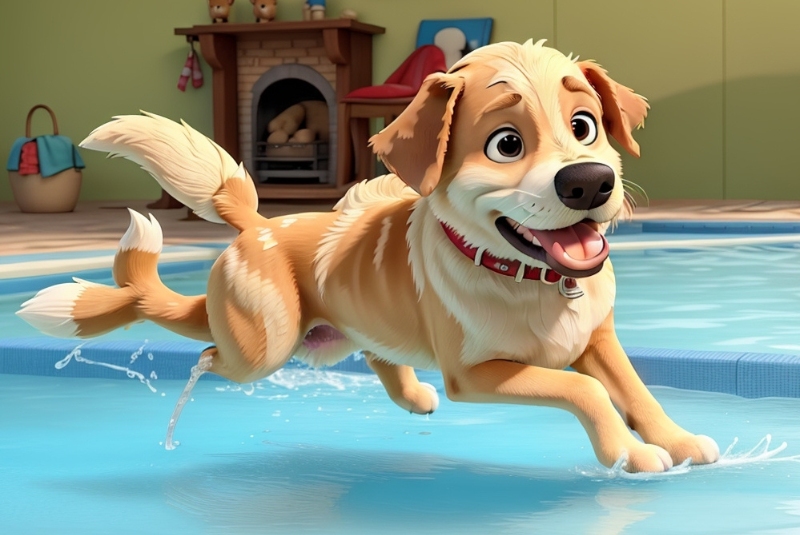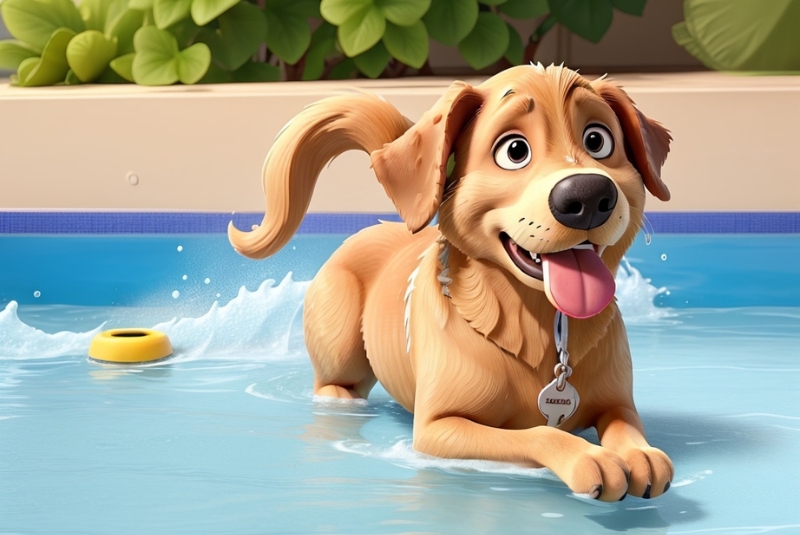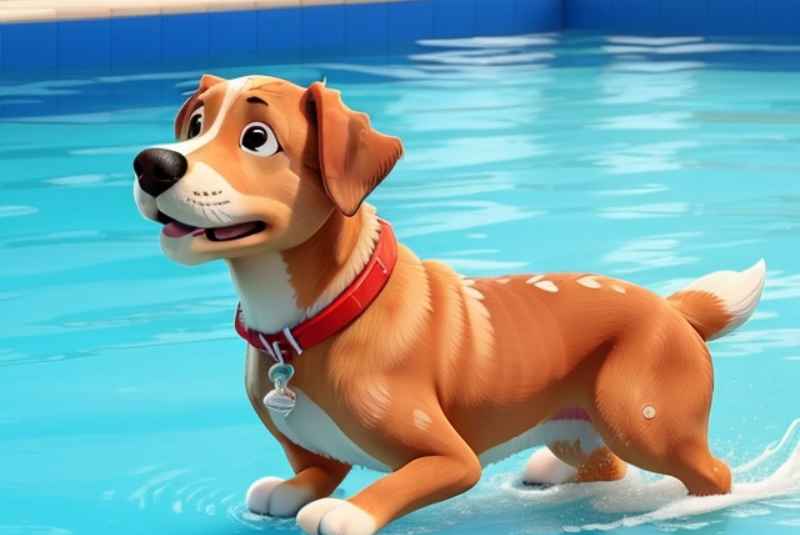If you are searching for “Why Does My Dog Pee in the House After Swimming?” If you’re a dog owner who enjoys taking your pet for a relaxing swim, you may have run into an unanticipated problem: your dog peeing inside your home after going for a swim. Even though this behavior might be annoying, there are good reasons behind it. In this post, we’ll examine the numerous causes of this occurrence and offer tips on how to manage it successfully.
Why Does My Dog Pee in the House After Swimming?
Dogs adore swimming, particularly on sweltering summer days. However, after a swim, some dog owners discover their dogs urinating inside. The fundamental causes of this behavior must be understood because they might be perplexing.
Read This Also: Why Do Dogs Chew on Potty Pads?
The Connection Between Swimming and Peeing
Dogs that swim have a variety of physical and psychological effects. Dogs may get more excited after a swim, which may cause unplanned urination. It’s important to understand that this behavior is frequently unintentional and not the consequence of disobedience.
Physical Sensations After Swimming

A dog’s bladder may be stimulated by the feeling of water and the cooling effect of swimming. Dogs can have the desire to urinate after being in the water, much like people occasionally do.
Territorial Marking
Dogs naturally mark their territory as part of their instincts. The impulse to mark interior places as a means of establishing ownership can be triggered by swimming in uncharted waters or even in one’s garden.
Excitement and Overstimulation
Although swimming is thrilling, Why Does My Dog Pee in the House After Swimming? and occasionally the excitement might cause a momentary loss of bladder control. Swimming’s sensory experience, coupled with physical effort, may cause inadvertent indoor urination.
Urinary Tract Infections
Dogs frequently have urinary tract infections (UTIs), which can result in urgent urination. The introduction of microorganisms from swimming in possibly polluted water increases the risk of urinary tract infections and subsequent indoor accidents.
Lack of Proper House Training
In certain circumstances, dogs that haven’t been properly housebroken might not be able to tell the difference between proper and improper urinal locations. Swimming may make it more difficult for them to choose where it is appropriate to release themselves.
Read This Also: Why Do Dogs Urinate Excessively?
Negative Associations
A dog may link swimming with being reprimanded if they have had unpleasant experiences or been chastised after swimming. This unfavorable relationship may cause worry, which may result in mishaps within.
Dealing with the Issue

1. Effective House Training Techniques
Review the fundamental housetraining methods with your dog. What Causes Why Does My Dog Pee in the House After Swimming? Encourage good behavior and give them plenty of chances to use the outside lavatory.
2. Post-Swim Drying Routine
After swimming, make sure your dog is completely dry. This may lessen the need to pee indoors by reducing bladder stimulation.
3. Maintaining a Consistent Schedule
The key is consistency. Whether your dog has had a swim or not, maintain a regular feeding and toileting routine.
4. Ensuring Proper Hydration
The probability of UTIs and the ensuing need to urinate indoors can both be decreased by maintaining enough water. Make sure your dog always has access to fresh water.
5. Consulting a Veterinarian
Consult a veterinarian if the problem continues. They can exclude medical issues and offer tailored guidance for your dog’s particular circumstances.
Overcoming the Challenge: Helping Your Dog Adjust to Post-Swim Behavior
As a loyal dog, What Causes Why Does My Dog Pee in the House After Swimming? It might be puzzling to see your pet urinate indoors after a swim. With the proper knowledge and approaches, you can overcome this difficulty, ensuring that both you and your dog may continue to enjoy aquatic activities without encountering any unpleasant shocks.
- Introducing Positive Associations
Building good connections with the overall experience is one method to combat the unfavorable associations some dogs may have with indoor urine after swimming. Establish a pattern that links swimming to other activities like rewards, playing, or even a soothing massage. This might assist in diverting your dog’s attention from any worry or anxiety.
- Reinforce House Training
It’s essential to review the fundamentals of house training, particularly if your dog appears to be unsure about where to discharge itself. Here, consistency is key. After a swim, keep an eye on your dog and take them outdoors as soon as they show indications of wanting to urinate. When they walk outside, compliment them to help them continue the desired behavior.
- Gradual Exposure
When your dog first starts swimming, the excitement and sensory overload may cause accidents indoors. Think about becoming wet gradually. Shorter swims and shallower locations should be used initially so that your dog can become used to the experience. This may lessen the likelihood of post-swim urination and assist in controlling their enthusiasm.
Read More Discussion on Quora: Do dogs pee in the pool?
- Leash Training
After swimming, using a leash can help your dog transition back inside without having an accident while also limiting their activity. Before going inside, gently guide your dog to the designated outside toilet. This lessens the possibility of indoor mishaps while enabling your dog to become used to returning to a regulated environment.
- Environmental Enrichment

Keeping your dog mentally and physically active will make them feel less anxious and excited after swimming. Their activity may be directed, and their propensity to pee indoors can be subdued with puzzle toys, smell games, and brief training sessions.
- Seeking Professional Guidance
In some situations, seeking expert advice may be necessary to solve the problem. A veterinarian behaviorist or a trained dog trainer can offer custom solutions to deal with your dog’s particular problem. They can identify the underlying causes, make suggestions for behavior modification methods, and assist you in putting a strategy to control the behavior into action.
Conclusion
In the above, we discussed Why Does My Dog Pee in the House After Swimming? After swimming, it’s a typical problem with a variety of underlying causes for dogs to pee in the home. You may assist your furry friend in enjoying swimming without the unwelcome consequences by comprehending the causes of this behavior and putting into practice appropriate techniques.
Is it normal for dogs to urinate after swimming?
Yes, it’s relatively normal due to the physical and emotional responses triggered by swimming.
Can I prevent my dog from urinating indoors after swimming?
Yes, by following proper house training techniques, maintaining a drying routine, and addressing potential medical issues.
How can I reduce the risk of urinary tract infections from swimming?
Ensure your dog swims in clean, safe waters, and maintain their overall hygiene and hydration.
What if my dog still urinates indoors despite following these steps?
If the problem persists, consult a veterinarian to rule out any medical conditions.
Can negative associations lead to indoor urination after swimming?
Yes, dogs might associate swimming with punishment, causing anxiety and subsequent accidents indoors.

1 thought on “Why Does My Dog Pee in the House After Swimming? Full Explanation”